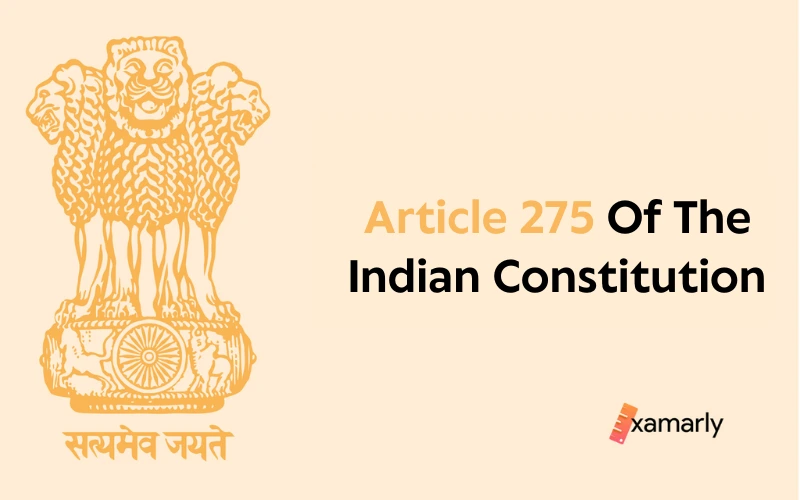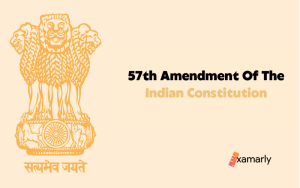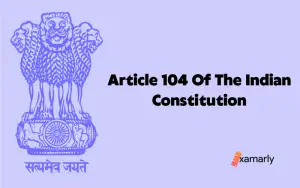An Overview
Welcome to our blog on Article 275 of the Indian Constitution. It deals with grants from the Union government to certain States.
The Constitution of India lays out provisions for financial assistance provided by the Union government to States and municipalities in need of assistance.
The blog will focus on the various forms of financial assistance provided by the Union government, and the impact of these grants on communities. We will also explore the role of the President in the distribution of these grants until such time that provisions are made by the Parliament.
Furthermore, the blog will also discuss the role of the Finance Commission in the distribution of grants and the consideration of its recommendations by the President.
Join us as we dive into the world of grants from the Union to certain states through Article 275 of the Indian Constitution. We will provide comprehensive information and analysis on the topic to help you understand the nuances of these grants and how they can be used to benefit the community.
- An Overview
- What Does Article 275 Of The Indian Constitution Deal With?
- Background Of Article 275 Of The Indian Constitution
- Clause (1) Of Article 275 Of The Indian Constitution: Explained
- Clause (2) Of Article 275 Of The Indian Constitution: Explained
- Summing Up
- FAQs Related To Article 275 Of The Indian Constitution
What Does Article 275 Of The Indian Constitution Deal With?
The provision contained in Article 275 of the Indian Constitution deals with the money that the government, or the Parliament, to be more specific, can give to certain States in the form of grants-in-aid to help them with their finances.
These grants-in-aid are charged to the Consolidated Fund of India each year and are determined by the Parliament. The purpose of these grants is to support the development of the States and promote the welfare of the Scheduled Tribes. It also aims to raise the level of administration of the Scheduled Areas. Additionally, there are specific provisions for the State of Assam for sums necessary to meet the costs of development schemes for the tribal areas and raise the level of administration in those areas.
Let us analyze this article of the Indian Constitution in more significant detail.
Background Of Article 275 Of The Indian Constitution
Let us first familiarise ourselves with the background of Article 275 of the Indian Constituton.
- Draft Article 255 for Article 275 of the Indian Constitution was discussed on 8 August 1949 and 9 August 1949, empowering the Parliament to make laws to provide financial assistance to states in the form of grants-in-aid charged to the Consolidated Fund of India.
- The Draft Article provided that the costs of promoting the welfare of Scheduled Tribes and managing Scheduled Areas would be paid back to States. These included the States that were once ruled by the British.
- Assam was also to receive financial assistance in the form of grants-in-aid. The reason for this grant was for managing specific tribal areas mentioned in Part I of the Sixth Schedule.
- The Chairman of the Drafting Committee proposed minor amendments to this Draft Article, including changing the phrase “revenues of India” to “Consolidated Fund of India”, including all States for the mandatory provision of compensation for expenditure on Scheduled Tribes and tribal areas, and changing the manner of calculating grants-in-aid to be given to Assam.
- Some Members were in opposition to the Draft Article. This was because it empowered the Parliament to make laws on financial assistance given to States.
- An alternative suggestion was that the President should be the one to decide on the amount of grants-in-aid to be given to states.
- A Member proposed that this Draft Article should be discussed after tribal areas have been constituted and that all the tribal areas should be integrated into one province and administered by an autonomous body under the Union government.
- A Member suggested that until the Parliament determines by law the amount to be distributed to states, the President would have the discretion to allocate grants-in-aid to the states.
- Draft Article 255 as amended, was adopted on 9 August 1949. The provision of Article 275 of the Indian Constitution was also extended to cover autonomous states in 1969.
Clause (1) Of Article 275 Of The Indian Constitution: Explained
275. Grants from the Union to certain States.
(1) Such sums as Parliament may by law provide shall be charged on the Consolidated Fund of India in each year as grants-in-aid of the revenues of such States as Parliament may determine to be in need of assistance, and different sums may be fixed for different States:
Provided that there shall be paid out of the Consolidated Fund of India as grants-in-aid of the revenues of a State such capital and recurring sums as may be necessary to enable that State to meet the costs of such schemes of development as may be undertaken by the State with the approval of the Government of India for the purpose of promoting the welfare of the Scheduled Tribes in that State or raising the level of administration of the Scheduled Areas therein to that of the administration of the rest of the areas of that State:
Provided further that there shall be paid out of the Consolidated Fund of India as grants-in-aid of the revenues of the State of Assam sums, capital and recurring, equivalent to—
(a) the average excess of expenditure over the revenues during the two years immediately preceding the commencement of this Constitution in respect of the administration of the tribal areas specified in [Part I] of the table appended to paragraph 20 of the Sixth Schedule; and
(b) the costs of such schemes of development as may be undertaken by that State with the approval of the Government of India for the purpose of raising the level of administration of the said areas to that of the administration of the rest of the areas of that State.
The first clause of Article 275 of the Indian Constitution talks about how money from the Consolidated Fund of India will be used to give financial help to certain States that are in need of it. The amount of money that will be given will be decided by the law made by the legislative powers of the Parliament of India and it may vary for different States.
This clause is concerned with the money that the government will give to certain States as grants-in-aid to help them with certain development projects that are for the welfare of a certain group of people, particularly the Scheduled Tribes or to improve the administration of certain areas such as the Scheduled Areas within the state. The money is withdrawn from the Consolidated Fund of India, and the projects must be approved by the Central Government of India. The government will provide the necessary capital and recurring sums to meet the costs of these development schemes.
In addition to this, sub-clause (a) of clause (1) of Article 275 of the Indian Constitution also explains that the government will give a certain amount of money to the State of Assam as grants-in-aid to help with the administration of certain tribal areas that are specified in Part I of a table in association with paragraph 20 of the Sixth Schedule of the Constitution. The money will come from the Consolidated Fund of India, and the government will give the State of Assam sums, capital and recurring, that will be equal to the average amount of money that the State spent more than it earned for the administration of these tribal areas in the two years before the Constitution came into effect.
Furthermore, the money that the government will give to the State of Assam will be used specifically for the administration of certain tribal areas as specified in a table in the Sixth Schedule of the Constitution. The State of Assam will be provided with sums, capital, and recurring, that will be equivalent to the average excess of expenditure over the revenues during the two years immediately preceding the commencement of this Constitution in respect of the administration of these tribal areas.
Sub-clause (b) of clause (1) of Article 275 of the Indian Constitution provides that the state of Assam will need to get the approval of the Government of India before undertaking any development schemes. The money that the government will provide will be used specifically to cover the costs of these schemes and the main purpose of these schemes will be to raise the level of administration of the said specific areas to that of the administration of the rest of the areas of the State of Assam.
[(1A) On and from the formation of the autonomous State under article 244A,
(i) any sums payable under clause (a) of the second proviso to clause (1) shall, if the autonomous State comprises all the tribal areas referred to therein, be paid to the autonomous State, and, if the autonomous State comprises only some of those tribal areas, be apportioned between the State of Assam and the autonomous State as the President may, by order, specify;
(ii) there shall be paid out of the Consolidated Fund of India as grants-in-aid of the revenues of the autonomous State sums, capital and recurring, equivalent to the costs of such schemes of development as may be undertaken by the autonomous State with the approval of the Government of India for the purpose of raising the level of administration of that State to that of the administration of the rest of the State of Assam.]
An addition was made to the first clause by the Constitution (Twenty-second Amendment) Act, 1969. The above-quoted text was added to the initial clause of Article 275 of the Indian Constitution.
Article 275 (1A) discusses the distribution of financial funds between different regions. It refers to Article 244A of the Indian Constitution which talks about the formation of an autonomous State, meaning a State with a high degree of self-government. The provision tells us that once this autonomous state is formed, there will be certain sums of money that are payable under a specific clause (a) of the second proviso to clause (1) of Article 275 of the Indian Constitution.
It goes on to say that if the autonomous State includes all the tribal areas mentioned in the clause, then all the sums of money will be paid to the autonomous State.
However, if the autonomous State only includes some of the tribal areas, then the President will decide how the money will be divided between the State of Assam and the autonomous State, by issuing an order. The President’s order will specify the exact amounts of money that will be paid to each region. This means the President will decide the apportionment of the funds between the State of Assam and the autonomous State.
The article further brings into discussion the financial assistance that will be provided to an autonomous State that has been formed under Article 244A. The financial assistance that will be provided to the autonomous State is in the form of grants-in-aid, which are funds that are given to a government or organization to help cover the costs of specific projects or programs.
The autonomous State is a State with a high degree of self-governance. Once such a State is formed, financial assistance will be provided to it from the Consolidated Fund of India. This is a fund that is maintained by the Government of India and is used to finance government expenses.
In this case, the grants-in-aid will be used to cover the costs of “schemes of development” that are undertaken by the autonomous State. These schemes are intended to improve the level of administration in the autonomous State to bring it up to the same level as the rest of the State of Assam.
The provision also states that the autonomous State must obtain the approval of the Government of India before undertaking these development schemes. This is likely to ensure that the schemes align with the development priorities of the government and are in line with the overall development strategy of the state of Assam.
Clause (2) Of Article 275 Of The Indian Constitution: Explained
(2) Until provision is made by Parliament under clause (1), the powers conferred on Parliament under that clause shall be exercisable by the President by order and any order made by the President under this clause shall have effect subject to any provision so made by Parliament: Provided that after a Finance Commission has been constituted no order shall be made under this clause by the President except after considering the recommendations of the Finance Commission.
The second clause of Article 275 of the Indian Constitution discusses the powers of the President in relation to those of the Parliament, specifically in regard to clause (1) of the same article. The clause states that until the Parliament, by its legislative power, makes a law about this specific clause, the President has the authority to make decisions about the powers given to the government through this clause. This means that the President has temporary or interim authority to make decisions about this specific clause until the government creates a law to govern it.
However, once a Finance Commission is established, the President’s authority to make decisions about this specific clause changes. The clause states that the President can only make decisions after considering the recommendations of the Finance Commission.
This means that the President must consult with the Finance Commission and take their advice into account before making any decisions about the powers given to the government through this clause. This is to ensure that the President’s decisions are informed by the expert advice of the Finance Commission, which is typically an independent body that advises the government on financial matters.
Summing Up
After giving Article 275 of the Indian Constitution a detailed reading, we can come up with the following conclusions.
- Article 275 of the Indian Constitution lays out provisions for financial assistance to be given to certain States in need.
- The funds will come from the Consolidated Fund of India, and the amount will be decided by laws made by the legislative powers of the Parliament and may vary for different states.
- The money will be provided in the form of grants-in-aid to help States with certain development projects, particularly for the welfare of Scheduled Tribes or to improve the administration of certain areas such as Scheduled Areas within the State.
- The projects must be approved by the Central Government of India, and the government will provide the necessary capital and recurring sums to meet the costs of these development schemes.
- The State of Assam will have to get the approval of the Government of India before undertaking any development schemes and the money provided by the government will be used specifically to cover the costs of these schemes.
- The second clause of Article 275 of the Indian Constitution discusses the powers of the President in relation to those of the Parliament.
- It states that until the Parliament makes a law about a specific clause (1) of the same article, the President has the authority to make decisions about the powers given to the government through this clause.
- Once a Finance Commission is established, the President’s authority to make decisions about this specific clause changes, and the President can only make decisions about this clause after considering the recommendations of the Finance Commission.
FAQs Related To Article 275 Of The Indian Constitution
What Is A Grant-In-Aid Under The Constitution Of India?
A grant-in-aid under the Constitution of India refers to financial assistance provided by the Union government to States and municipalities in need of assistance. These grants are charged to the Consolidated Fund of India each year and are determined by the Parliament.
What Is The Consolidated Fund Of India?
The Consolidated Fund of India is the main fund of the Government of India, into which all revenues received by the government and all loans raised by it are deposited. It is the main repository of the government’s revenues and expenditures.
The Consolidated Fund is used for the payment of the government’s expenses, including the salaries of government employees, pensions, and other recurring expenses, as well as for the financing of development projects. Money can be withdrawn from the Consolidated Fund only by the authority of the Parliament.
What Is The Finance Commission Of India?
The Finance Commission of India is a constitutional body established under Article 280 of the Indian Constitution. It is responsible for making recommendations to the President of India on the distribution of revenue between the Union government and the States, as well as on the principles to be followed in the grants-in-aid to the States from the Consolidated Fund of India.
It is appointed every five years and is composed of a Chairman and four other members, who are appointed by the President of India.
Who Decides The Amount To Be Distributed Between The State Of Assam And The Autonomous State As A Grant-In-Aid?
The President of India decides the amount to be distributed between the State of Assam and the autonomous State as a grant-in-aid.
What Is An Autonomous State?
An autonomous State in India refers to a region within a State that has a certain degree of self-government and administrative autonomy. These regions may have their own elected government and Legislative Assembly, as well as the power to make laws for certain subjects within the jurisdiction of the State.
Examples of autonomous States in India include the North-Eastern states of Meghalaya, Mizoram, Nagaland, and the Union Territory of Puducherry. These states have a certain level of autonomy in decision-making and are empowered to make laws on certain subjects such as land and police. However, they are still subject to the authority of the Union government and the Constitution of India.






